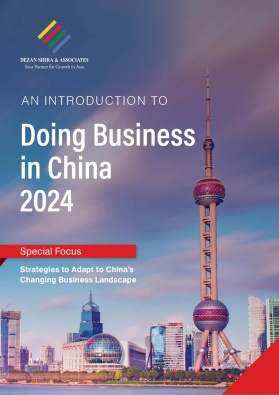Decoding China 2024 Green Industry Catalogue: Key Takeaways
China recently unveiled the 2024 version of its Green Industry Catalogue, which includes new industries and provisions that align with China’s ambitious green and low-carbon transition goals. By providing clear guidelines and definitions, the Catalogue will facilitate the development of tailored policies to attract green investment in China, enhance green financing tools, and support environmentally friendly initiatives.
On February 29, 2024, China’s National Development and Reform Commission (NDRC), in collaboration with nine other major departments, released the eagerly anticipated 2024 Edition of the Catalogue of Industries for Green and Low-carbon Transition (hereinafter referred to as the “2024 Green Industry Catalogue”).
The 2024 Green Industry Catalogue builds upon the foundation of its previous version, the Catalogue of Green Industries, which was first published in 2019 (hereinafter, the “2019 Green Industry Catalogue”).
The importance of the 2024 Green Industry Catalogue is a key reference document for government entities and departments to devise supportive policies for the advancement of green sectors in China. Through revisions to industry definitions and updated itemized classification, the 2024 version of the catalogue aid key stakeholders in strategic planning and allocation of resources. It directs the actions of policymakers, investors, and businesses, steering their endeavors toward nurturing the expansion of eco-friendly industries throughout China.
In particular, the 2024 Green Industry Catalogue holds high significance for China’s rapidly developing green finance sector, as it offers direction to banks and financial institutions on facilitating financial tools like green bonds.
What’s new in the 2024 Green Industry Catalogue?
Compared to its previous edition, one notable change in the 2024 Green Industry Catalogue is the renaming from “Catalogue for Green Industries” to “Catalogue of Industries for Green and Low Carbon Transition”, indicating a broader focus on decarbonization objectives within existing industries.
Besides, the 2024 Green Industry Catalogue contains 22 more items than the 2019 Catalogue, clustered in seven categories, namely:
- Energy saving and carbon reduction;
- Environmental protection;
- Recycling;
- Clean energy;
- Ecological protection and restoration;
- Green infrastructure upgrading; and
- Green services (newly included in the 2024 Green Industry Catalogue).
The 2024 Green Industry Catalogue introduces several new industries to its framework. These include (but are not limited to):
- Logistics;
- Information technology infrastructure; and
- Hydrogen energy, including full-chain equipment manufacturing for production, storage, transportation, and use of hydrogen energy.
Along with the addition of new industries, the 2024 Green Industry Catalogue broadens its focus areas to comprehensively cover the impetus for green and low-carbon transition. The expanded focus areas include:
- A broader spectrum of greenhouse gas controls, indicates a heightened emphasis on emissions management and reduction strategies.
- Increased attention towards green technology product research and development, certification, and promotion, reflecting an intensified commitment to innovation and sustainability in product design and manufacturing.
- Introduction of novel pollutant treatment methods, signaling a proactive approach towards addressing environmental challenges and enhancing pollution control measures.
Background
The 2024 Green Industry Catalogue is borne out of China’s ongoing efforts to advance its commitment to environmental sustainability alongside economic development. Recognizing the importance of sustainable growth, the Chinese government has expanded its focus to encompass a wider range of initiatives.
The 2024 Green Industry Catalogue classifies its industrial coverage at three levels via primary, secondary, and tertiary catalogues. Within these respective catalogues, industries crucial for green and low-carbon transformation are specified, alongside updated requirements for relevant sectors. The 2024 Green Industry Catalogue strengthens the orientation of green development within the specified industries, fostering a conducive environment for sustainable practices.
How the 2024 Green Industry Catalogue could impact China’s green finance sector
In the context of green finance, the 2024 Green Industry Catalogue provides a framework for identifying eligible green projects and activities.
This clarity is essential for financial institutions and investors seeking to channel funds towards environmentally sustainable initiatives. By aligning with the catalogue’s standards, green finance initiatives can ensure transparency, credibility, and effectiveness, ultimately contributing to the overall goals of environmental protection and sustainable development.
Historically, China’s criteria for defining green bonds have been less stringent compared to international standards, leading to confusion and potential greenwashing. Different regulatory bodies, such as the People’s Bank of China (PBOC), the NDRC, and the China Securities Regulatory Commission (CSRC), each had their own guidelines for green bonds, contributing to market confusion.
To address these issues, the NDRC first compiled the 2019 Green Industry Catalogue to provide a unified basis for identifying green industries and aligning with international standards. Subsequently, in 2020, the PBOC, in conjunction with the NDRC and the CSRC, jointly issued a consultation paper on the Green Bond Endorsed Project Catalogue (the “Green Bond Catalogue”), building upon this foundation by further unifying the standards for China’s green bonds. It aimed to provide clarity and consistency in defining green projects, regardless of whether they are financed through green financial bonds, green domestic corporate bonds, or green bonds issued by listed companies and corporate asset-backed securities.
In 2021, the Green Bond Catalogue was updated to its current edition. It introduces more precise and scientific definitions for green projects, enhances methods for bond issuance and management, and offers a framework that balances stability and adaptability for domestic green bond development.
Key takeaways for businesses
China has actively sought to align its green taxonomy with international standards, aiming to improve the assessment and certification of green bonds while ensuring the regulated development of green bond instruments.
In November 2021, China and the EU introduced the Common Ground Taxonomy – Climate Change Mitigation, facilitating the comparison and identification of similarities and differences between their respective taxonomies. This initiative reflects China’s eagerness to engage in the global market.
With substantial capital investments (estimated at US$450-570 billion) needed to meet its green targets, China is welcoming foreign investment and expertise to meet international norms. Since June 2020, qualified foreign institutional investors have enjoyed unrestricted access to China’s securities market, setting the stage for further growth in the country’s green bond market, which represented less than 1 percent of the overall bond market in 2020.
As China moves to limit coal usage, opportunities for strategic investment emerge in green infrastructure and clean energy sectors, such as wind and solar power generation, where green finance is expected to play a pivotal role in the near future.
About Us
China Briefing is one of five regional Asia Briefing publications, supported by Dezan Shira & Associates. For a complimentary subscription to China Briefing’s content products, please click here.
Dezan Shira & Associates assists foreign investors into China and has done so since 1992 through offices in Beijing, Tianjin, Dalian, Qingdao, Shanghai, Hangzhou, Ningbo, Suzhou, Guangzhou, Dongguan, Haikou, Zhongshan, Shenzhen, and Hong Kong. We also have offices in Vietnam, Indonesia, Singapore, United States, Germany, Italy, India, and Dubai (UAE) and partner firms assisting foreign investors in The Philippines, Malaysia, Thailand, Bangladesh, and Australia. For assistance in China, please contact the firm at china@dezshira.com or visit our website at www.dezshira.com.
- Previous Article China Adopts New Regulations to Facilitate Cross-Border Data Flows
- Next Article Shanghai Introduces New Guidelines for Cosmetic Advertising







